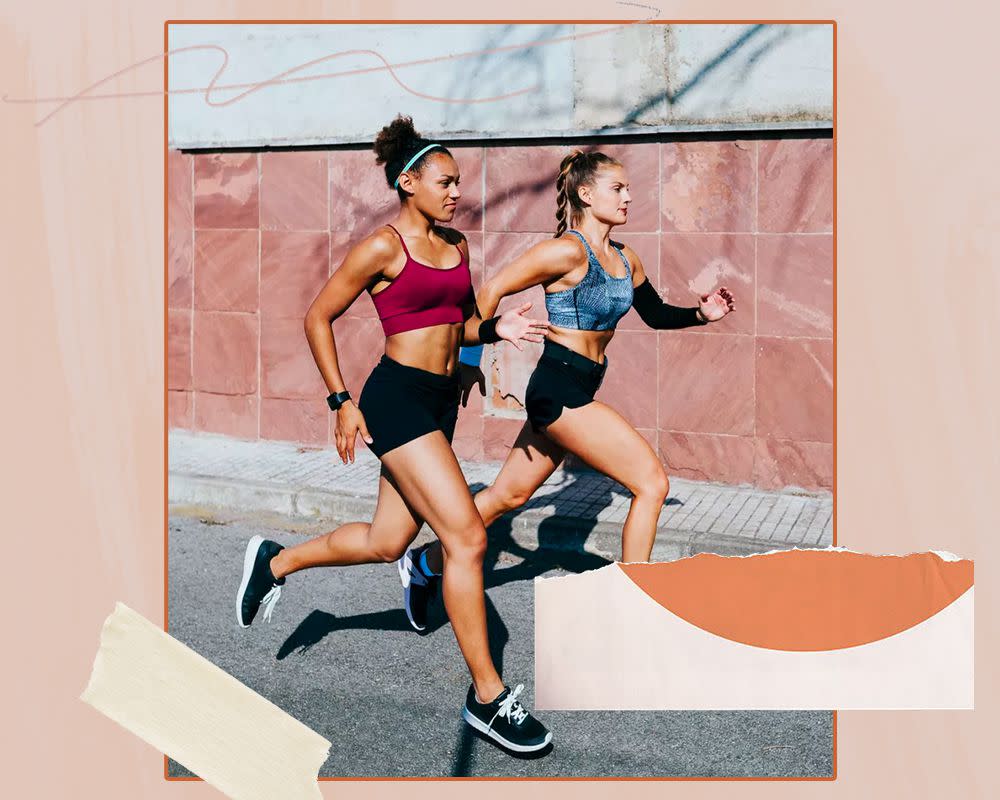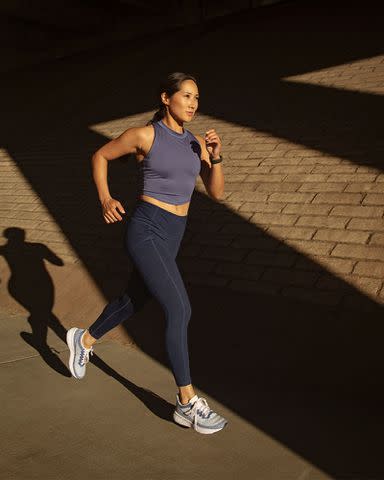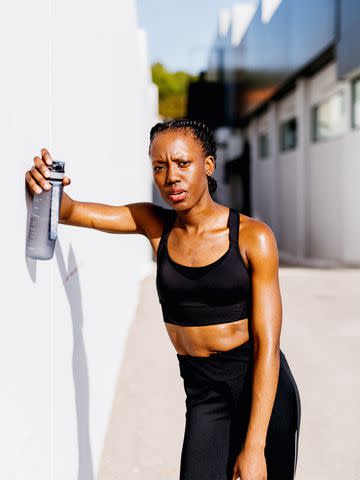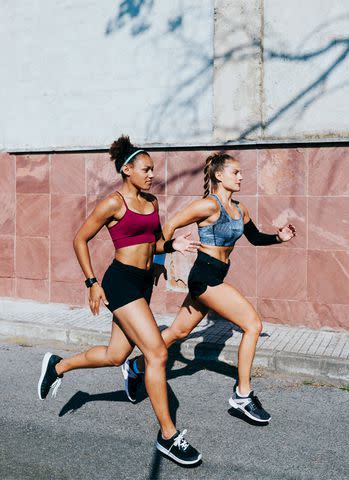Everything You Need to Know About LISS: The Low Intensity Cardio Gaining Favor

Stocksy / Design by Bailey Mariner
Reviewed by Traci CopelandFact checked by Anna Harris
There’s been a steady stream of buzz over HIIT (high-intensity interval training) for the past few years, but it's slower-paced sibling has recently reemerged to rival its spotlight. LISS or (low-intensity steady-state) is a form of cardio that, although less strenuous than its popular counterpart HIIT, can deliver many of the same cardiovascular benefits as well as work wonders for your mental health. The workout has already become a favorite for fitness bloggers and gym enthusiasts alike.
What is LISS?
LISS (low-intensity, steady-state) is a training style that involves performing a cardio activity—running, biking, walking, swimming, etc.—at a low intensity for a sustained period, typically 30-60 minutes.
While the idea isn’t exactly new—it was a huge hit among bodybuilders in the 1960s and '70s, go figure—it’s enjoying a resurgence in popularity, as fitness pros are always on the quest to optimize exercise training and examine the what, how, and why behind the best workouts. And, we tapped one of these fitness experts to find out everything you need to know about LISS training.
So, if you’re keen to explore the flip side of HIIT, keep scrolling for our complete guide to LISS training.
Meet the Expert
Brie Ogletree is a NASM-Certified Personal Trainer and a Precision Nutrition Level 1 Coach with several years of personal training, group coaching, and online training experience.
What Is LISS?
LISS is an approach to cardio training that’s the total opposite of HIIT. Instead of blasting through short bursts of vigorous activity before panting through a relative rest interval, LISS cardio involves longer bouts of continuous exercise at a lower intensity or slower pace. It’s about building your aerobic endurance and overall body conditioning, rather than all-out power, speed, and metabolic stoking.
What Are the Benefits of LISS?

Getty Images / Tetra Images
Ogletree says that the primary benefit of LISS cardio is that it improves heart health and circulation, reducing the risk of heart disease. But, the benefits don’t end there.
It aids recovery.
Ogletree notes that LISS is a smart option for the day after a strenuous strength training workout or hard-effort day. Because LISS gets your heart pumping blood throughout your active body, your muscles may receive nutrients to heal any micro-damage incurred from your intense workouts and clear out metabolic waste products. The result? Enhanced recovery and less soreness, so that you’re primed to attack your next hard training session.
It’s an approachable workout for beginners.
Even if it’s been so long since you’ve laced up your sneakers that you’ve forgotten where they are, you can safely jump into a LISS workout. LISS is perfect for all fitness levels because you’re simply exercising at a low intensity, and that intensity is relative to you. It doesn’t matter if someone else can jog an 8-minute mile pace for their LISS workouts; if you’re staying in the right intensity zone while walking a 20-minute mile, you’re doing it exactly right.
It burns calories.
Like any exercise, LISS burns calories. “LISS cardio may also help you achieve a caloric deficit, which is critical for weight loss or fat loss goals,” says Ogletree. But, Ogletree cautions against buying into the common misconception that cardio is the best way to burn calories and lose weight. Strength training and HIIT workouts are likely to torch just as many—if not more—calories during and after the workout.
It can get you outside.
Many cardio activities that are great for LISS workouts can be enjoyed outdoors. Whether you're hiking, walking, running, biking, rollerblading, cross country skiing, kayaking, or snowshoeing, getting fresh air while you exercise can improve your mood. While any exercise can have a mood-boosting effect, research has found that exercising outdoors may boost mood more than exercising inside. It also can be more engaging and enjoyable.
It’s a good option if you’re tired.
If it’s been a long day, and you just can’t imagine mustering the energy to run sprints or power through heavy squats, a LISS workout can be an attractive alternative. You can still get your body moving, and work towards your fitness goals while avoiding the strenuous, high gears of a more vigorous workout.
It increases your endurance.
Training for a marathon? Want to hike the Grand Canyon? LISS workouts may form the foundation for training for endurance events.
It relieves stress.
Though exercise is generally a potent stress buster, hard workouts produce cortisol (a stress hormone) and tax the body and mind the same way that a work deadline or near accident might. In fact, a 2008 study found that whereas high-intensity exercise increases cortisol, low-intensity exercise actually decreases it. Thus, LISS, carries all of the stress-relieving benefits of exercise without imposing any additional stress.
It’s free.
You don’t need any special equipment or a gym membership to partake in LISS. You can walk, hike, jog, or stream a Vinyasa Flow class from the comfort of your living room.
What Are the Drawbacks of LISS?

MARC BORDONS / Stocksy
Though it would be great if everything in life only came with positives, LISS—like most everything—has a few drawbacks.
It can be boring.
“LISS cardio can be repetitive and boring, especially in a gym setting, where you’re stuck on a machine staring at whatever is in front of you,” says Ogletree. But, Ogletree suggests recruiting a friend to join you for your workout to combat any boredom. “Because you are working at lower intensities, it should be fairly easy to hold a conversation,” she says.
It takes more time.
LISS workouts are, by definition, less intense than HIIT workouts, so they are less efficient. Though the benefits of exercise far exceed burning calories, you have to spend a lot more time doing easy or moderate workouts than vigorous ones to achieve the same calorie burn.
It can increase your appetite.
Ogletree claims that LISS can increase the hunger response and appetite. “For sessions longer than 30 minutes, it is very possible that LISS can make you hungrier, due to the large energetic demand required to sustain the activity,” she explains. “Eating more is not a problem unless you have a weight loss or fat loss goal, where this can become counterproductive.”
Byrdie Tip
After a workout, you should eat a healthy snack with protein and carbohydrates to replace the nutrients lost, according to the Academy of Nutrition and Dietetics. Skip the sugary or processed foods and opt for Greek yogurt with berries, turkey on a whole grain wrap, or a small smoothie made with low-fat milk and fruit.
It can cause overuse injuries.
“Another drawback is it may make you more fatigued and lead to overtraining or overuse injuries,” cautions Ogletree. You must give your body adequate time to rest and recover, particularly from high-impact activities like running, and to balance out your training with resistance exercises, stretching, and mobility work. “Building strength through exercises like squats, lunges, deadlifts, bent-over rows, and push-ups will keep your muscles strong and resilient,” explains Ogletree. “Mobility and flexibility exercises will [also] help you continue to move well.”
To avoid overtraining, the best advice is to listen to your body. “Keep in mind that exercise should enhance your life, not make you feel worse. If you’re noticing feeling run down, [or experiencing] chronic fatigue, brain fog, or prolonged muscle soreness for long periods (over several days or weeks), this could be a sign of overtraining and you may want to back off,” advises Ogletree.
Who Should Do LISS?
The short answer: everyone. If you’re new to exercise or just getting back into it, starting with LISS will help you slowly increase your fitness levels without risking the injuries or over-exertion that can crop up with more intense workouts. If you’re a fitness junkie, you still need LISS in your well-balanced workout routine for cardiovascular training and recovery—not to mention the stress-reduction and mental health benefits.
How to Do LISS Properly

BONNINSTUDIO / Stocksy
This is the best part: Whether you love running, walking, hiking, swimming—even rollerblading, there’s no set type of exercise that’s best for LISS. Plus, you don’t need an expensive private trainer or fancy app to get going. “LISS is pretty straightforward because you maintain the same intensity throughout the workout,” says Ogletree. “For any given exercise modality, don’t go higher than 65 percent of your max heart rate.” Don’t worry: if you don’t have a heart rate monitor, aim for an effort level of 5-6 on a scale of 1-10 (10 being your absolute maximum, giving-it-everything effort).
Ogletree says that whether you’re walking, rollerblading, rowing, on the elliptical trainer, give your body a few minutes to warm up and get up to that working intensity. “LISS workouts can be as short at 5 minutes or as long as 60 minutes depending on your fitness level and goals,” she explains. But, more isn’t necessarily better. Stick within the 30-60 minute range. Beyond that, your workout may start taxing the body much more than intended with LISS.
Who Uses LISS?
We do! But you’ve likely gathered that by now. Among other fans of LISS includes, fitness personality Kayla Istines, who swears by balancing her famous HIIT workouts with at least one LISS session a week. Celebrity trainer Michael Blauner also revealed that LISS is a huge part of the regimen that gets the Victoria’s Secret Angels, including Adriana Lima, catwalk-ready. And hey, it sure seems to be working well for them.
Up Next: Weightlifting Is Crucial for Hitting Weight Loss Goals—Here's What You Need to Know
Read the original article on Byrdie.

